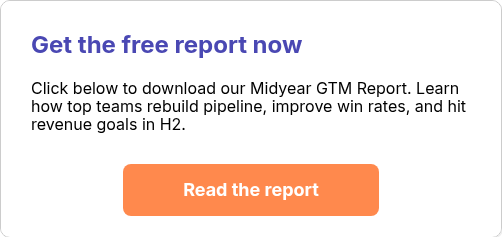This is the final part of our Root Cause Analysis series on why sales teams fall behind by midyear.
In Part 1 we broke down operational drag, those behind-the-scenes inefficiencies like misaligned territories, bad data, and process breakdowns. Then in Part 2, we tackled inconsistent execution, where reps go through the motions but don’t actually move deals.
Now, real gut punch. Pipeline deficit.
Because it doesn’t matter how clean your ops are or how consistent your reps get, if the top of the funnel is dry, it’s game over.
The mid-year reality check
It’s Q3. The pressure’s on. Forecasts are fragile. Board expectations haven’t changed.
But pipeline? That’s another story.
According to multiple 2025 surveys, 71% of sales development teams are delivering less than half the pipeline their orgs need. And 63% say outbound is their #1 challenge.
Most teams enter Q3 already behind plan. In fact, last year, 57% of companies were behind at the halfway mark.
The takeaway? Even high-performing sales teams are struggling to keep the pipeline engine running and the problem isn’t just execution. It’s volume, coverage, and targeting.
Why pipeline generation falls short
There’s no single reason teams fall behind. It’s usually a mix of predictable issues, most of which creep in quietly over time.
Here are the top culprits:
- Over-reliance on inbound: Inbound is a bonus, not a strategy. When traffic dips or lead quality drops, entire teams feel it.
- Weak outbound infrastructure: No clear ICP. No consistent motion. SDRs guessing who to reach out to.
- Low volume, bad targeting, weak messaging: The triple threat. Too few touches, to the wrong people, with the wrong pitch.
- Misaligned coverage: Some reps sit on 300 untouched accounts. Others burn through their books too fast. Either way, opportunities are getting missed.
And let’s be honest, most teams don’t realize they have a pipeline problem until it's already too late.
The math has changed
It used to be that 3x coverage was a safe bet. Not anymore.
With win rates declining to 17–20%, modern teams are now aiming for 4–5x pipeline coverage just to hit goal.
That means if your team has a $1M quota for the quarter, you need $4–5M in real, forecastable pipeline by week 2 of Q3. Not fluff. Not “maybe next quarters.”
If you’re not there, it’s time to reset.
How to diagnose a pipeline deficit
Before you sound the alarm, do a quick pulse check across these core questions:
- Are coverage ratios strong across each segment (not just in aggregate)?
- Where are conversion rates lowest by source, rep, or deal stage?
- Is the SDR-sourced pipeline contributing at least 50% to the top of funnel?
- Are reps working high-fit, high-intent accounts, or just volume?
- Has the team refreshed targeting and messaging in the last 90 days?
If the answer to most of these is “not really,” you’ve got a gap that won’t close on its own.
What high-performing teams are doing differently
The best teams aren’t waiting around for leads to appear. They’re building outbound motions that scale and self-correct.
Here’s what that looks like:
- Redefining outbound as a system: Not a side hustle. Not “do it when you can.” Outbound is a repeatable motion with clear cadences, shared language, and manager accountability.
- Targeting, not guessing: Top teams use tools like Gradient Works to segment their TAM and assign only the highest-potential accounts to SDRs and AEs. That means no more chasing ghosts, and a lot more control over pipeline inputs.
- Measuring contribution, not just activity: If SDRs are booking meetings but not building pipeline, something’s off. High-performing orgs track opportunity creation and win rates by source, not just meeting volume.
- Fixing coverage gaps in real time: Static books and outdated territories kill momentum. The best teams refresh books dynamically so reps are always working active, high-fit accounts.
- Upping the messaging game: Spray-and-pray is dead. Great outbound teams equip reps with sharp, persona-specific messaging and sequences tied to real buyer pain.
What to do next
If you’re already behind on pipeline, and many teams are, there’s still time to fix it. But you have to get focused.
Here’s what to prioritize immediately:
- Recalculate your coverage ratios against quota and win rate
- Audit your outbound motion: reps, tools, cadences, messaging
- Review segment performance and rebalance books where needed
- Tighten your lead-to-opportunity funnel to remove friction
- Align outbound around specific plays or microsegments instead of general prospecting
Pipeline shortfalls don’t happen overnight. They build quietly over quarters when outbound slows, books go stale, or reps start chasing the wrong targets.
But the fix doesn’t require a full reset. With the right systems, sharp targeting, and some urgency, your team can still turn things around in H2.
The earlier you spot the gaps, the faster you can close them.




.png)
